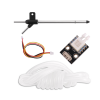Blake_Flynn
New Member
Good day to you all,
I am new this community and looking for advice on the feasibility for a project. I would like to use a quadcopter to accurately measure wind speed and direction at various altitudes. This post is the beginning of my journey and I'd like suggestions on how to achieve this, best hardware for the purpose and generally some suggestions on developing this capability.
Thank you in advance for any guidance you can provide.
I am new this community and looking for advice on the feasibility for a project. I would like to use a quadcopter to accurately measure wind speed and direction at various altitudes. This post is the beginning of my journey and I'd like suggestions on how to achieve this, best hardware for the purpose and generally some suggestions on developing this capability.
Thank you in advance for any guidance you can provide.



